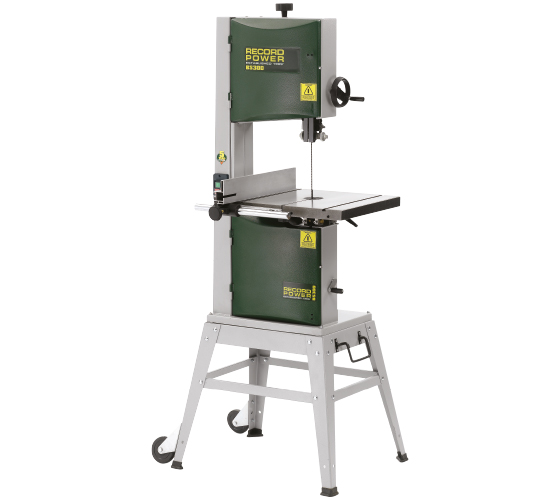Product Support
Status:
Current Product
Warranty:
5 Years from Purchase
Full Details
Spares Available:
Yes
Serial Number:
Yes
BS300E 12" Bandsaw

Pedal Wheel Kit:

Jockey Bar Wheel Kit:

Tilting Table:

Integral Legstand:

Integral Standard Wheel Kit:

Cast Iron Table:

Cast Iron Band Wheels:

Mitre Fence Included:

Cam-Action Tensioner:

Two Speeds:

Maximum Depth of Cut: 190 mm
Throat Depth: 305 mm
Table Size: 480 x 400 mm
Table Height from Floor: 990 mm
Motor input P1: 1 kW
Motor output P2: 0.75 kW
Blade Length: 93 1/4"
Blade Width Capacity: 1/4 - 3/4"
Blade Speed: 820 & 380 M / minute
Extraction Port Diameter: 100 mm
Weight: 80 kg
Size: H1690 x W880 x D680 mm
Compatible Accessories:

Knowledge Base Links
Bandsaw Blade Pulls to One Side When Cutting
There are three main reasons for this happening:
1. The blade itself has lost its set on the teeth. By replacing the blade with a good quality blade this problem will be overcome. Losing the set off a blade unfortunately is common when cutting re-claimed timber and the only way to remedy the problem is to replace the blade.
2. The blade is worn and no longer sharp, again by replacing the blade with a good quality blade this problem will be overcome.
3. If the blade however is in perfect condition then the most probable cause is that the blade is undertensioned.
Bandsaw Blade Tooth Damage
My bandsaw blade loses its edge on the inside of the blade first resulting in cutting at an angle. I can only overcome this by feeding wood into the blade at an angle. Is the setup at fault or have I blunted the inside edge on something hard?
The blade usually performs in this way if the set of the teeth has become damaged or worn on one side. The guides may be set too close to the teeth causing damage or the blade may have worn naturally if you have been cutting curved work on a regular basis. The best option would be to start by replacing the blade, but make sure that all blade guides are well clear of the blade before fitting, and re- adjust the guides after the blade has been tracked and tensioned correctly.
Bandsaw Blade Tracking
Question:
The tracking and tension of the blade on my bandsaw have been correctly set and adjusted but after a few cuts the blade moves to the front edge of the bandwheels, and on one occasion flew off the wheels altogether.
Answer:
If you tension the blade fully after tracking you will alter the tracking, this may be the problem. When tracking, the wheel needs to be spun quite a few revolutions by hand for the blade to settle down and find its line. The blade should be tracked to the centre of the top wheel. It also advisable to check the thrust bearings position on the blade guides to make sure these are not forcing the blade forward and off the wheels. Blade tension should also be checked because an under-tensioned blade will move on the bandwheels when a work piece is being cut and pressure is being applied to the blade.
Best Bandsaw Blade for Ripping 5" Dry Ash
Question:
Can anyone suggest the ideal bandsaw blade? I'm ripping 5 inch dry ash using the old version of the Startrite 352.
Answer:
For ripping we recommend the widest blade possible which on the 352 is 3/4". And for deep cutting such as yours we recommend as coarse a blade as possible - say a 3 skip.
If your machine was made before 2003 it will most likely be a 352S model which uses blades of 112" length. We would therefore recommend the BB1123403 - from our own range.
But whichever make of blade you go for we would plump for 3/4" wide and as coarse as you can get.
Clunking Bandsaw Blade
Question:
I've fitted the blade of your recommendation and it's working well apart from the 'clunking' noise as the weld passes through the guide heads. I have tried smoothing the weld with abrasive and have used a stone on the back edge of the blade but this has made no difference. Is this a normal (acceptable) characteristic of bandsaws?
Answer:
Please just check that there is about 1 mm clearance from the back of the blade to the thrust rods and that you can get a thin piece of paper between the side of the blade and the blade guides. Please also remember the same settings need checking under the table and work in the same way.
However, to a certain degree this occurs with many blades and machines and as long as the cutting performance is OK and the teeth are not in contact with any part of the machine there should not be a problem.
Parallel Cuts on the Bandsaw Are Wedge Shaped
When I try to cut parallel edges the blade pulls in and I get wedged shaped result.
This problem is caused by the table being set incorrectly and not square to the blade, causing the rip fence to run out of line. Re-align the table square to the blade by using a straight edge. Table adjustment can generally be found where the table is mounted to the trunnion (quadrant) for further details on this consult your manual.














